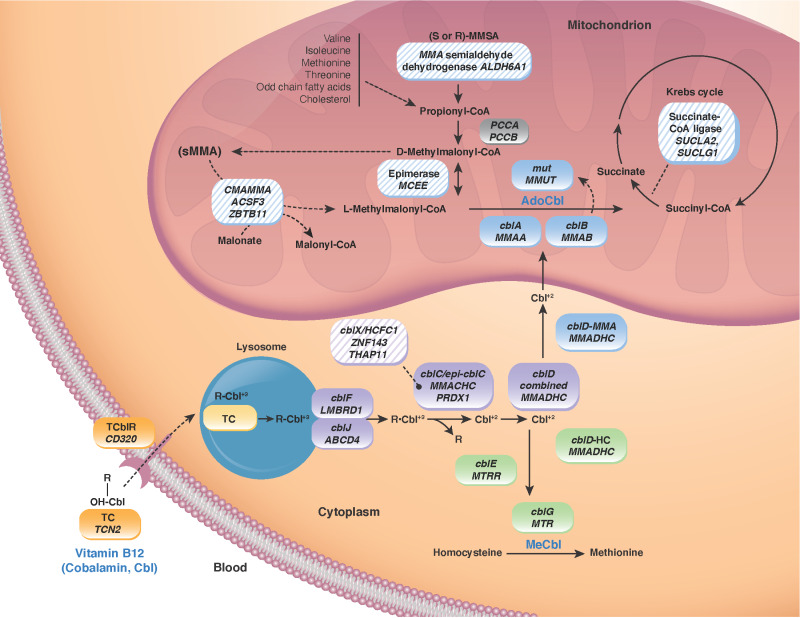Major pathway of the conversion of propionyl-CoA into succinyl-CoA. The biotin-dependent enzyme propionyl-CoA carboxylase converts propionyl-CoA into D-methylmalonyl-CoA, which is then racemized into L-methylmalonyl-CoA and isomerized into succinyl-CoA, a Krebs cycle intermediate. The L-methylmalonyl-CoA mutase reaction requires 5'-deoxyadenosylcobalamin, an activated form of vitamin B12. The pathway of cellular processing of cobalamin (reduction from Cbl+3 to Cbl+2) and subsequently formation of adenosyl- (AdoCbl) and methylcobalamin (MeCbl) is depicted. Adenosyl-cobalamin is the cofactor of the methylmalonyl-CoA mutase reaction; methylcobalamin is the cofactor of the methionine synthase reaction.
The color-coded boxes around the cobalamin-processing enzymes indicate their role in causing: (1) methylmalonyl-CoA mutase or isolated AdoCbl deficiency and associated increase in serum methylmalonic acid [sMMA] (blue); (2) isolated MeCbl deficiency and hyperhomocysteinemia (green); (3) both cofactor deficiencies causing elevations in MMA and homocysteine (purple). Note: The light blue striped boxes indicate the enzymes (and the genes encoding them) that are deficient in different disorders in which methylmalonic acidemia occurs: epimerase deficiency (MCEE) and succinate-CoA ligase deficiency (SUCLA2/SUCLG1), combined malonic and methylmalonic acidemia (ACSF3, ZBTB11), and methylmalonyl-semialdehyde dehydrogenase deficiency (ALDH6A1). The light purple striped box indicates cblX deficiency (HCFC1), the only X-linked disorder in this pathway and rare transcription factors (ZNF143, THAP11) or neighboring genes (PRDX1) associated with cblC deficiency or epi-cblC. See Disorders of Intracellular Cobalamin Metabolism.
MMA = methylmalonic acid; Cbl = cobalamin; Cbl+3 = oxidized cobalamin, Cbl+2 = reduced cobalamin; AdoCbl = 5'-deoxyadenosylcobalamin; MeCbl = methylcobalamin; TC = transcobalamin; TCblR = transcobalamin receptor.
The genes (and the enzymatic subtypes) associated with isolated methylmalonic acidemia included in this GeneReview are:
MMUT (mut0, mut–)
MMAA (cblA)
MMAB (cblB)
MMADHC (cblD-MMA)
MCEE
Isolated methylmalonic acidemia caused by mutation of SUCLA2 and SUCLG1 is discussed in SUCLA2-Related Mitochondrial DNA Depletion Syndrome, Encephalomyopathic Form with Methylmalonic Aciduria and SUCLG1-Related Mitochondrial DNA Depletion Syndrome, Encephalomyopathic Form with Methylmalonic Aciduria, respectively.


